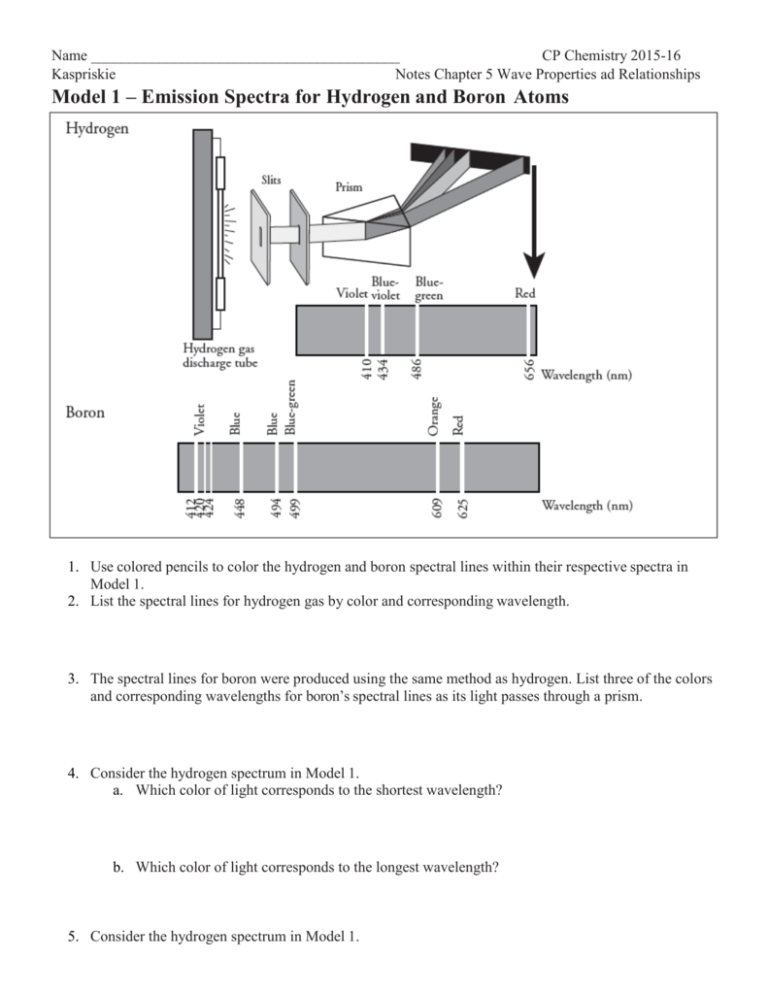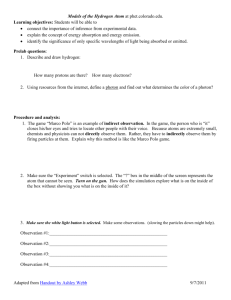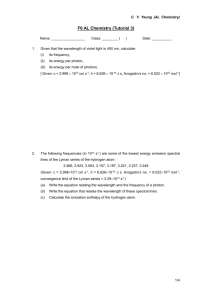Energy Emission Spectra and Bohr Model POGIL
advertisement

Name _________________________________________ CP Chemistry 2015-16 Kaspriskie Notes Chapter 5 Wave Properties ad Relationships Model 1 – Emission Spectra for Hydrogen and Boron Atoms 1. Use colored pencils to color the hydrogen and boron spectral lines within their respective spectra in Model 1. 2. List the spectral lines for hydrogen gas by color and corresponding wavelength. 3. The spectral lines for boron were produced using the same method as hydrogen. List three of the colors and corresponding wavelengths for boron’s spectral lines as its light passes through a prism. 4. Consider the hydrogen spectrum in Model 1. a. Which color of light corresponds to the shortest wavelength? b. Which color of light corresponds to the longest wavelength? 5. Consider the hydrogen spectrum in Model 1. a. Which color of light has the most energy? b.Which color of light has the least energy? 6. Does a gas discharge tube filled with boron emit the same wavelengths of light as a tube filled with hydrogen? Use evidence from Model 1 to support your answer. 7. “The spectral lines for atoms are like fingerprints for humans.” How do the spectral lines for hydrogen and boron support this statement? READ THIS! Niels Bohr modified Rutherford’s Nuclear Atom model to explain how light interacted with the electrons in an atom to produce spectral lines. His model included electrons orbiting the nucleus at specific energy levels. Electrons absorb energy from various sources (electricity) when they move from lower energy levels (ground state) to higher energy levels (excited states). Energy is released as electrons return to their lower energy levels. 8. Is energy absorbed or released for the electron transition shown in the diagram to the right? Explain. Model 2 – Bohr Model of a Hydrogen Atom 9. Identify the drawing in Model 2 that depicts a hydrogen atom with an electron moving from energy level 5 to energy level 2. a. Label the correct picture with “n=5 to n=2” and list the corresponding color of light emitted. Refer to Model 3 to identify the color of this transition. b. This electron transition (absorbs/releases) energy. (Circle one) c. This electron moves from a (lower/higher) energy state to a (lower/higher) energy state. (Circle one) d. Is energy, in the form of light, absorbed or released in the electron transition? 10. Label the remaining drawings in Model 2 with the electron transitions that are occurring (n=? to n=?), the wavelengths, and the corresponding colors. See Model 1 in order to identify the color of spectral lines produced in each of the hydrogen atom electron transitions shown in Model 2. Remember the relationship between energy and wavelength to help identify the spectral line that corresponds to each transition. Use colored pencils to trace the light wave in each of the four pictures with the appropriate color. 11. Consider the electron transitions in Model 2. Which of the electron transitions involves the most energy? 12. Explain why a single atom of hydrogen cannot produce all four hydrogen spectral lines simultaneously. 13. If Question 12 is true, how can we see all four colors from a hydrogen gas discharge tube simultaneously?









